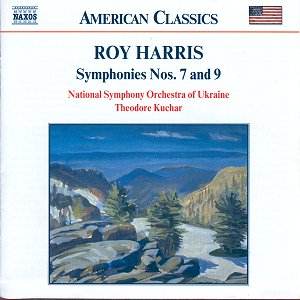Conductor and orchestra have given us a number of highly
impressive discs recently in the American Classics series – not least
the superb Piston Violin Concertos – and with Arthur Fagen conducting
the Ukrainians have notched up a Martinu Symphony cycle that is more
than merely serviceable. Now Theodore Kuchar and the orchestra turn
to the laureate of American symphonists and do him proud.
The Seventh dates from 1952 and was revised in 1955.
A one movement nineteen minute work, not dissimilar in size from the
Third, it presents more compelling evidence as to Harris’ stature as
not only the greatest of all American composers but as one of the mid-centuries’
greatest masters of form, mutation and assimilation of material. What
sleeve note writer Richard Whitehouse calls Harris’ powers of "metamorphosis"
are abundantly in evidence here, from the ominous and dramatic tread
of the drum and the brass, string and woodwind’s striving figure at
the opening of the work. At 7’30 that mutative metamorphosis begins
capped at 10’05 by the appearance of bells and shivering strings and
the side drum’s tattoo which leads to renewed vigour in the orchestral
attack. His legendary wit appears at 13’10, the rhythmic kick, bucked
by frantic drums, brass and raucous wind leading to an episode in which
muted brass, over a pizzicato back beat, and some bluesy clarinet are
all integrated into the fabric of the score and emanate, as it were,
from within it with absolute congruity. Harris’ language is absorptive
but never forced or vulgar. This kind of scherzando section leads onto
a final peroration beginning from around 16’ – a sonorous, deep tuba
sonority spreading like liquid through the score over which strings
curve and ascend and a spirit of increasing confidence burgeons. The
xylophone rings out before a concerted rhythmic attack features raucous
trombones sliding up and down like New Orleans tailgate trombonists
on a polite day. Into the fray ride the newly energised trumpets sweeping
all before them and the work ends in a spirit of unstoppable joy. I
admit it – I was on my feet.
The well-placed central work is the Epilogue to Profiles
in Courage – J.F.K, Harris’ poignant but not treacly tribute to John
F Kennedy. Tubular bells announce the sonorous and elegiac tread of
the eight-minute work. The strings keen but Harris’ paragraphs are strategically
short so that the threnody never becomes one of seamless ease and searing
consolatory simplicity. Instead its progress is relatively hard won,
the
disruptive drum and side drum interjecting and adding
a fractiously austere funeral march patina to the work. At 6’ there
is a solo tattoo on the drum and reduced dynamics leads to a thoughtful
withdrawal, reflection and recollection – no drums now intrude, only
the strings’ quietude concerns us, as they slowly fade from our hearing
into the silence of eternity.
The Ninth Symphony was commissioned by the Philadelphia
Orchestra and first performed in 1962, predating the Kennedy threnody.
It’s in three movements each introduced with lines from the Preamble
to the US Constitution and Whitman’s Leaves of Grass. It
opens in optimistic, open-air fashion with a piano introducing a folk-like
section before a reassertion of the opening brazen confidence – high
violins and drum vigour, the lower strings insinuating themselves underneath.
The fractious and mean spirited trumpets are ignored by the bulk of
the orchestra and a sort of vocalised folk song emerges – beautiful
and transient – before some tremendous orchestral pile driver incidents
lead to each section having its say in the collective argument. The
slow movement "…to form a more perfect Union" is characterised
by Whitehouse as a kind of Pavane. Certainly however the building blocks
of Harris’ lyricism are audible; cantilena strings, the precise division
of the string section with subsidiary motifs for lower strings, the
reliance on the energy of the pizzicato to galvanise rhythm (not unlike
the role of the bass in jazz), the independence of the brass section,
especially trumpet, high woodwinds. Listen especially to the seesawing
high woodwind at 5’00 as the passion increases, both melodically and
dynamically, and what is generated is a sense of almost spiritual implacability.
The last movement is divided into three parts. Vigorous horns and trumpets
swamp the texture, the trumpets especially punchy and bossy, riding
over the percussion interjections. After a quiet oboe interlude Harris’
rhythmically often jagged but muscular prose reasserts itself and full
but not clotted orchestration reappears. The brass rises and falls,
the strings come on like folk fiddlers, Harris imbuing the music with
sectional independence but orchestral cohesion, launching a favoured
violin arabesque as a riposte to the earlier caustic frivolities perhaps.
Back comes a striding swinging trumpet figure and a percussion led cry
of triumph – high woodwind, side drum, dramatic drum roll and audible
reminiscences of the opening of the symphony. We’re back home and the
journey was an exhilarating one.
These are superb performances: not the subtlest of
recordings but frankly who cares. With works like these to listen to
it’s a privilege to spend time with Roy Ellsworth Harris.
Jonathan Woolf


